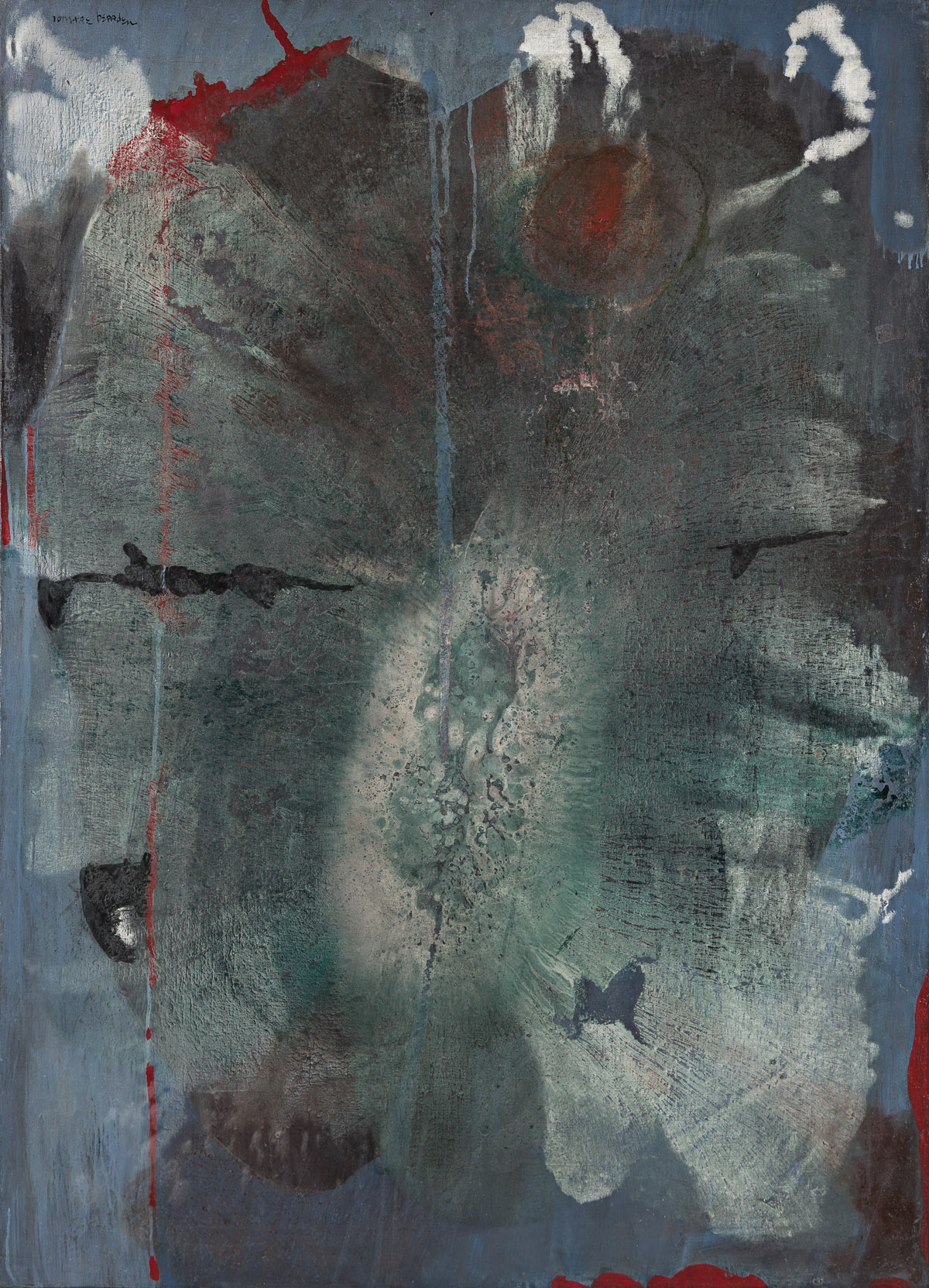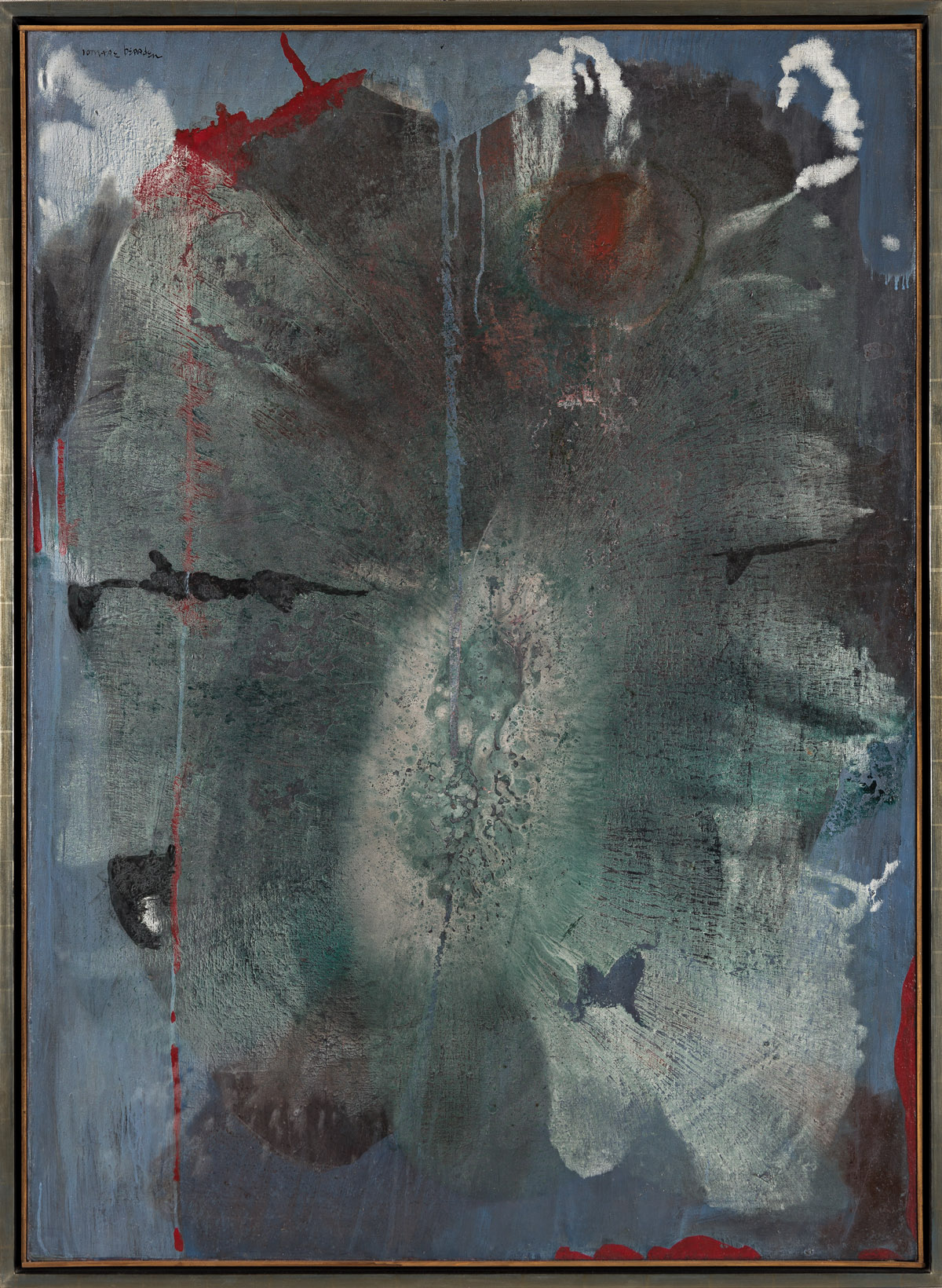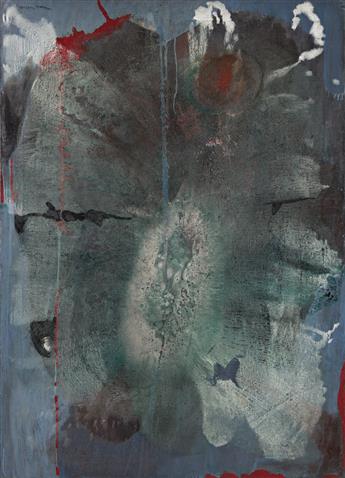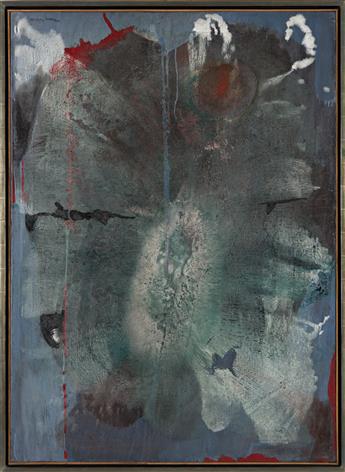Sale 2616 - Lot 45
Unsold
Estimate: $ 150,000 - $ 250,000
ROMARE BEARDEN (1911 - 1988)
Wine Star.
Oil on linen canvas, 1959. 1473x1067 mm; 58x42 inches. Signed in oil, upper left recto. Titled in oil, upper left verso.
Provenance: the artist; Michael Warren Gallery, New York; private collection, France (circa 1965); private collection, New York (2006); private collection (2015), acquired at Swann Galleries, December 15, 2015.
Exhibited: Michael Warren Gallery, New York, January 20 - February 19, 1960, with a fragment of the gallery label on the frame back; Abstract Romare Bearden, DC Moore Gallery, New York, February 13 - July 13, 2020; Romare Bearden: Abstraction, traveling exhibition, organized by the American Federation of Art and curator Dr. Tracy Fitzpatrick of the Neuberger Museum of Art, Gibbes Museum of Art, Charleston, SC, October 15, 2021 – January 9, 2022, the University of Michigan Museum of Art, Ann Arbor, MI February 5 – May 15, 2022.
Michael Warren Gallery was later renamed Daniel Cordier and Michael Warren Gallery, Inc. in 1961 before becoming Cordier and Ekstrom in 1962. This painting was included in a group of late 1950s abstract canvases exhibited in this solo exhibiton.
Illustrated: Roberta Smith, "Romare Bearden's Seen Abstract Side", The New York Times, March 19, 2020.
Wine Star is an excellent and significant example from Romare Bearden's period of abstract color field painting of the late 1950s. Bearden's development of abstraction was influenced by non-Western intuitive approaches to imagery. In the mid-1950s, Bearden had an interest in Zen Buddhism and studied calligraphy and Chinese landscape painting with a Chinese calligrapher. His late 1950s works display less of an interest in the activity of action painting of expressionism, as described by his friend the writer Harry Henderson in a 1989 interview - "He found a rationale by studying Zen philosophy. His works were always serene and lacked the tremendous physical involvement employed by the Abstract Expressionists." Sharon Patton also described a "mystical elegance" in these abstract works, and the influence of Chinese painting is found in their asymmetry and an entry point into the painting. Patton illustrates this phase with Bearden's Blue is the Smoke of War, White the Bones of Men, circa 1960, from the Harry B. Henderson collection and sold at Swann Galleries on September 15, 2005.
Bearden's abstract painting impresses with its vital fluidity and technical virtuosity. Roberta Smith's rave review of the 2020 DC Moore exhibition of Abstract Romare Bearden posits his abstract painting's significance; "they effortlessly claim a place in the history of American postwar abstraction, stain painting division." These beautiful paintings embrace accident, staining and the canvas through a technique of pouring, staining, dispersion and dripping. While Bearden's period of experimental painting is later than the mid-1950s celebrated color field painting of Morris Louis and Helen Frankenthaler, his experimentation was independent; as Smith put it simply, "Bearden developed it on his own". This notable chapter in his development has been largely overlooked until recently. The abstraction of Bearden is now the subject of a national traveling museum exhibition organized at the Neuberger Museum of Art by its director Tracy Fitzpatrick. Fine p. 222; Gelburd/Rosenberg p. 40; Patton p. 173.
Wine Star.
Oil on linen canvas, 1959. 1473x1067 mm; 58x42 inches. Signed in oil, upper left recto. Titled in oil, upper left verso.
Provenance: the artist; Michael Warren Gallery, New York; private collection, France (circa 1965); private collection, New York (2006); private collection (2015), acquired at Swann Galleries, December 15, 2015.
Exhibited: Michael Warren Gallery, New York, January 20 - February 19, 1960, with a fragment of the gallery label on the frame back; Abstract Romare Bearden, DC Moore Gallery, New York, February 13 - July 13, 2020; Romare Bearden: Abstraction, traveling exhibition, organized by the American Federation of Art and curator Dr. Tracy Fitzpatrick of the Neuberger Museum of Art, Gibbes Museum of Art, Charleston, SC, October 15, 2021 – January 9, 2022, the University of Michigan Museum of Art, Ann Arbor, MI February 5 – May 15, 2022.
Michael Warren Gallery was later renamed Daniel Cordier and Michael Warren Gallery, Inc. in 1961 before becoming Cordier and Ekstrom in 1962. This painting was included in a group of late 1950s abstract canvases exhibited in this solo exhibiton.
Illustrated: Roberta Smith, "Romare Bearden's Seen Abstract Side", The New York Times, March 19, 2020.
Wine Star is an excellent and significant example from Romare Bearden's period of abstract color field painting of the late 1950s. Bearden's development of abstraction was influenced by non-Western intuitive approaches to imagery. In the mid-1950s, Bearden had an interest in Zen Buddhism and studied calligraphy and Chinese landscape painting with a Chinese calligrapher. His late 1950s works display less of an interest in the activity of action painting of expressionism, as described by his friend the writer Harry Henderson in a 1989 interview - "He found a rationale by studying Zen philosophy. His works were always serene and lacked the tremendous physical involvement employed by the Abstract Expressionists." Sharon Patton also described a "mystical elegance" in these abstract works, and the influence of Chinese painting is found in their asymmetry and an entry point into the painting. Patton illustrates this phase with Bearden's Blue is the Smoke of War, White the Bones of Men, circa 1960, from the Harry B. Henderson collection and sold at Swann Galleries on September 15, 2005.
Bearden's abstract painting impresses with its vital fluidity and technical virtuosity. Roberta Smith's rave review of the 2020 DC Moore exhibition of Abstract Romare Bearden posits his abstract painting's significance; "they effortlessly claim a place in the history of American postwar abstraction, stain painting division." These beautiful paintings embrace accident, staining and the canvas through a technique of pouring, staining, dispersion and dripping. While Bearden's period of experimental painting is later than the mid-1950s celebrated color field painting of Morris Louis and Helen Frankenthaler, his experimentation was independent; as Smith put it simply, "Bearden developed it on his own". This notable chapter in his development has been largely overlooked until recently. The abstraction of Bearden is now the subject of a national traveling museum exhibition organized at the Neuberger Museum of Art by its director Tracy Fitzpatrick. Fine p. 222; Gelburd/Rosenberg p. 40; Patton p. 173.
Exhibition Hours
Exhibition Hours
Aliquam vulputate ornare congue. Vestibulum maximus, libero in placerat faucibus, risus nisl molestie massa, ut maximus metus lectus vel lorem.






